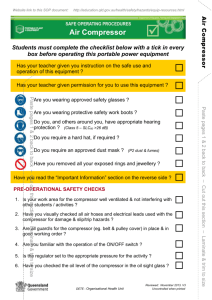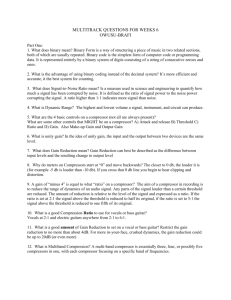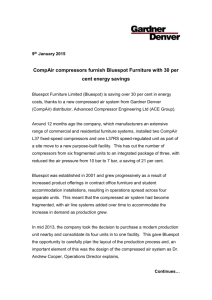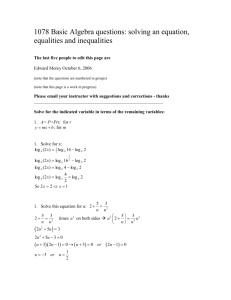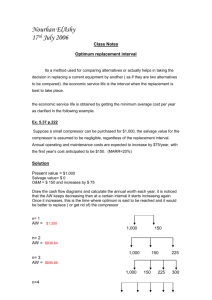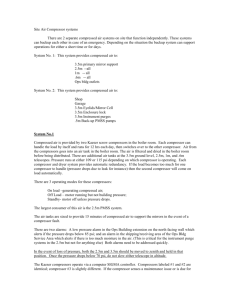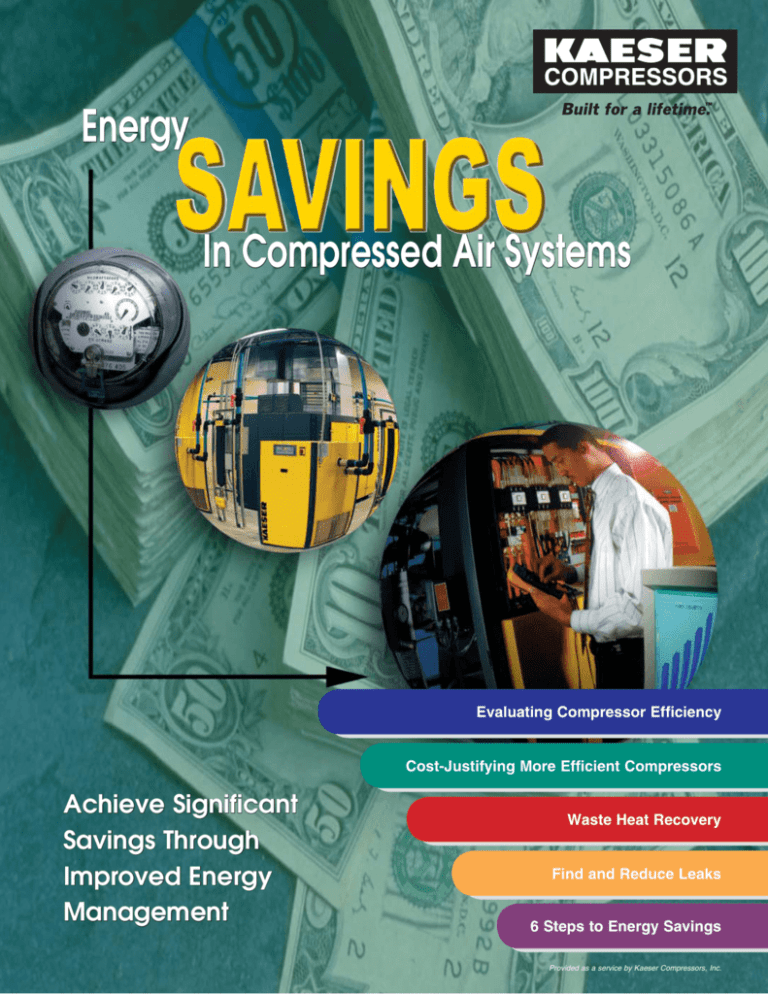
Energy
In Compressed Air Systems
Evaluating Compressor Efficiency
Cost-Justifying More Efficient Compressors
Achieve Significant
Savings Through
Improved Energy
Management
Waste Heat Recovery
Find and Reduce Leaks
6 Steps to Energy Savings
Provided as a service by Kaeser Compressors, Inc.
Evaluate your compressed air costs
and potential savings
Compressed air is your
most expensive utility
as two times greater than–the initial cost
of the air compressor. Over a 10-year
operating period, a 100 hp compressed
This is a fact that has been documented
time and time again. It takes 7 to 8 hp of
electricity to produce 1 hp in an airtool.
Yet this high energy cost quite often is
overlooked. Here are some questions
air system that you bought for $40,000
will accumulate up to $800,000 in electrical power costs. Following a few simple
steps can significantly reduce energy
costs as much as 35%.
you should ask yourself:
Do you know your compressed air costs?
Do you know how much compressed air
Air Demand Analysis (ADA)
We’ve helped thousands of customers save millions of dollars through
compressed air best practices. We’ve
refined and improved conventional air
audit techniques to develop Kaeser’s
Air Demand Analysis (ADA) program.
No other approach to compressed air
system analysis offers Kaeser ADA’s
unique combination of affordability,
convenience, and comprehensiveness.
Suitable for analysis of large or
small systems. Kaeser’s ADA is an
exceptional tool. With the data we
gather, our compressed air specialists
can identify areas for improvement in
both energy savings and air delivery.
Our field service experts have
the knowledge, the experience and
the tools to study true life-cycle costs
– to evaluate your air system, and
make solid recommendations that will
reduce energy costs up to 50% and
often increase productivity.
Maintenance costs can also
be lowered. In fact, our customers
typically find that a properly operating
system reduces their preventive and
trouble-shooting activities by as much
30%.
ass 3
0%.
0%
is really required for your plant?
70% of Your Long-Term
Compressor Cost is
Electricity
Analyze the total cost of a compressed
Do you select compressed air equipment
air system and you’ll realize that power
with energy costs in mind?
cost is significant. In just one year it
Do you monitor the use of compressed
air like your other utilities?
This brochure gives you the information you need to answer these questions,
could exceed the cost of the compressor itself. Over a period of ten years,
this could consume 70% of your overall
costs.
That’s why it is important to investi-
save energy and improve your com-
gate energy efficiency when considering
pressed air system operation.
a new compressor.
Why evaluate energy costs?
Depending on plant location and local
power costs, the annual cost of electrical power can be equal to–or as much
Chart 1
2 Visit our Website: www.kaeser.com
Identifying the electrical cost
of compressed air
result will be about $750/hp per year in
To judge the magnitude of the opportuni-
Select the most efficient
control
ties that exist to save electrical power
costs in your compressed air system, it
is important to identify the electrical cost
of compressed air. Chart 1 shows the
relationship between compressor hp and
energy cost. In addition, consider the
following:
lower energy costs.
The magnitude of the above is solely
dependent on the ability of the compressor control to translate reduced air flow
into lower electrical power consumption.
Chart 2 shows the relationship
between the full-load power required for
Direct cost of pressure
a compressor at various air demands
Reliable Controls
Every 10 psig increase of pressure in a
and common control types. It becomes
plant system requires about 5% more
apparent that the on line—off line control
power to produce.
(dual control) is superior to other controls
For example: A 500 cfm compressor,
in translating savings in air consumption
delivering air at 110 psig, requires about
into real power savings. Looking at our
100 hp. However, at 100 psig, only 95
example of reducing air consumption
hp is required. Potential power cost sav-
from 500 cfm to 380 cfm, the compressor
ings (at 10 cents per kWh; 8760 hours) is
operating on dual control requires 82% of
$7025 per year.
full-load power. That is 12% less energy
Developed by Kaeser in conjunction
with Siemens AG, this patented
compressor control features an
industrial based PC with an Intel®
microprocessor inside. Five different
compressor control configurations are
available to precisely match compressor performance to air demand and
increase energy savings.
Indirect cost of pressure
than when operated on modulation con-
System pressure affects air consumption
trol. If the air consumption drops to 50%,
on the use or demand side. The air
the energy savings is increased even
system will automatically use more air at
further, to 24%.
97 psi 187°F R
on load
higher pressures. If there is no resulting
increase in productivity, air is wasted.
Increased air consumption caused by
higher than needed pressure is called
artificial demand.
With Sigma Control, compressor
systems can be monitored and
adjusted from any location worldwide.
Sigma Control also features extensive
capabilities for maintenance trending
and air demand tracking.
An unregulated system using 500
cfm at 110 psig system pressure will
consume only 380 cfm at 80 psig. The
potential power cost savings (500 cfm 380 cfm = 120 cfm = 24 hp, at 10 cents/
kWh; 8760 hrs.) is $16,864/year.
Also remember that the leakage rate
is significantly reduced at lower pressures.
The cost of wasted
air volume
Each cfm of air volume wasted can be
translated into extra compressor hp and
is an identifiable cost. As show by
Chart 1, if this waste is recovered, the
*Assumes adequate storage.
Chart 2
Kaeser Energy Savings in Compressed Air Systems Guide 3
*8760 hours is based on operating
24 hours/day, 7 days/week, 52 weeks/year.
Justify a more energy-efficient
compressed air system
Look beyond the
purchase price
As noted earlier, the electrical power
What are the components
of an air energy-efficient
compressor?
costs of a compressed air system impact
Compressor element (airend) - perfor-
the bottom line far more than initial price
mance can vary up to 20% depending on
and maintenance. How can we evaluate
what airend size and style is used.
the true impact each element of the
Drive motor efficiency - at the 100 hp
compressed air system has on the
size, there is a maximum efficiency
electrical power costs?
difference of no more than 2% between
The air compressor package
EPAct and premium efficiencies.
Referring to the previous example, a
The air compressor package has a very
Sigma Profile Airend
Airend performance is critical to the
compressor’s overall efficiency and
thus the compressor’s energy consumption and operating costs. The
Sigma Profile airend, developed by
Kaeser Compressors, can save up
to 20% in energy consumption. The
Sigma Profile is standard on Kaeser
rotary screw compressors. Units are
available from 5 to 3000 cfm with
discharge pressures up to 217 psig.
Rotary screw compressors produce
virtually pulsation-free air.
significant impact on overall operating
100 hp compressor would save $1500
annually.
power costs. There are other pieces of
Compressor controls - are an impor-
equipment in a compressed air system
that support the air compressor. These
also impact on power costs, both directly
and indirectly, but the core of it all is the
air compressor package. Energy wasted
at the air compressor site can never be
tant part of the air compressor package,
matching compressor supply to demand.
As outlined previously, the right control
type is essential for efficient operation.
Savings of 45% are possible (refer to
Chart 2). Any reduction of air usage in a
recovered.
system accomplished by good demandside management (adequate storage and
flow controls) can be translated into real
power cost savings.
Important Formulas
(hp) (0.7457) (power rate) (hours)
Power cost =
motor efficiency
(volts) (amps) (1.732) (motor eff.) (power factor)
Horsepower (3 ph) =
746
(volts) ( amps) (motor eff.) (power factor)
Horsepower (1 ph) =
4 Visit our Website: www.kaeser.com
746
State-of-the-art control systems generate large savings.
System master controls
A microprocessor-integrated controller
Reduce pressure drop in
system components
allows the system to maintain a stable
When buying or replacing equipment,
system pressure and ensures that only
make sure it maintains low pressure drop
needed compressor units are operating
over its entire service life. Also, ensure
at their most efficient level.
that filters and dryer are sized and
User-friendly, PLC-based controllers
maintained properly. The total pressure
can mix and match compressor supply
drop across all compressed air system
to demand, including automatically shut-
components, including piping, should not
ting off units not needed, and bring on
exceed 15 psi.
backup units as required.
Advanced controllers not only
sequence and select units as required,
but also ensure that no more than one
unit in a multiple-unit installation will be
operating at inefficient part load. All other
units will be operating efficiently at full
load.
Electrical power savings result from
operating fewer compressors at a lower
pressure than with conventionally
controlled compressors.
Efficiency Rules of Thumb
¾ Air compressors normally deliver 4 to 5 cfm
per horsepower at 100 psig discharge
pressure.
¾ Leak costs add up quickly. Just one 1/16”
leak at 100 psig consumes 6.5 cfm (approx.
1.5 hp).
¾ Total pressure drop across all compressed air
system components, including piping, should
not exceed 15 psi.
¾ Size air storage tanks and pipes based on your
demand profile. Many systems lack adequate
storage. Larger tanks are often an inexpensive
way to improve system performance.
¾ Compensating for pressure drop consumes
about 1% more power for every 2 psi adjustment at the compressor.
¾ Power cost for each 1 horsepower operating
constantly for one year at 10 cents per kwh is
about $750.
¾ A 50 hp compressor rejects heat at
approximately 126,000 Btu per hour.
Approximately 119,600 Btu/hr of this is
recoverable.
Kaeser Energy Savings in Compressed Air Systems Guide 5
Remote Monitoring
Sigma Air Manager combines the
benefits of modern industrial PC
technology with Internet technology
to provide unparalleled compressor control, monitoring and reports.
Optional software provides enhanced
reporting and enables end users to
control air system operation from any
location worldwide.
Heat Recovery
Implementing heat recovery
The heat generated by air compressors
can be used effectively within a plant
for space heating and/or process water
heating. Considerable energy savings
result in short payback periods.
Process heating: Heated water is available from units equipped with water-
Top exhaust compressors facilitate energysaving heat recovery without adding to
system footprint.
the manufacturer’s maximum backpressure allowance. When space heating is used in the winter, arrangements
should be made in the ductwork to return
some of the heated air to the compressor
room in order to maintain a 60°F room
temperature. This ensures that the air
discharged is at comfortable levels.
Heat recovery is particularly effective
cooled oil coolers and aftercoolers.
when the primary air compressor pack-
Generally, these units can effectively
age is an oil-cooled rotary screw type.
discharge the water at temperatures
Estimating the real energy savings
between 130°F and 160°F.
in dollars must include identifying the
Space heating: The heated cooling air
actual cost of the current energy source
from the compressor package is ducted
(natural gas, electric, propane, etc.).
to an area that requires heating. If duct-
(See chart below.)
work is used, be careful not to exceed
Energy Savings Through Heat Recovery
Btu savings/yr. = 0.95* x compressor hp x 2545 Btu/hp x hrs operation/yr.
$ savings/yr. =
Btu savings/yr.
x $ fuel cost/unit of alternate fuel
Btu/unit of alternate fuel
*air cooled
Btu/unit of alternate fuels:
Electricity
=
Natural gas =
#2 oil
=
3413 Btu/kWh
1000 Btu/cu ft
138,500 Btu/gal
Gasoline =
Kerosene =
Propane =
125,000 Btu/gal
135,000 Btu/gal
91,500 Btu/gal
Flow Controllers
Most compressed air systems operate at
artificially high pressures to compensate
Intermediate flow controls reduce leak
losses and artificial demand while maintaining optimum pressure and flow.
artificial demand.
A flow controller separates the
for flow fluctuations, leaks and down-
supply side (compressors, dryers, and
stream pressure drops caused by lack of
filters) from the demand side (distribu-
“real” storage and improperly designed
tion system). It creates “real” storage
piping systems. Even if additional com-
within the receiver tank(s) by accumulat-
pressor capacity is available, the time
ing compressed air without delivering
delay caused by bringing the necessary
it downstream. The air pressure only
compressor(s) on-line would cause
increases upstream of the flow controller
unacceptable pressure drop.
in the air receiver, while the flow control-
Operating at these artificially high
ler delivers the needed flow downstream
pressures requires up to 25% more com-
at a constant, lower system pressure.
pressor capacity than actually needed.
This reduces the actual flow demand by
This 25% in wasted operating cost can
substantially reducing leakage and artifi-
be eliminated by reducing leaks and
cial demand.
6 Visit our Website: www.kaeser.com
Find and reduce costly leaks
Leaks are expensive. Statistics show
ating pressure to another chosen level.
that the average system wastes between
From this you can calculate the leak rate.
25 and 35% to leaks. A 3/8” leak at 100
psig, for example, may cost $31,200
per year (see chart below). The higher
the system pressure, the more air lost
through leaks.
Routine leak monitoring and repair is
essential to control costs. Equip maintenance personnel with proper leak detection equipment, and train them in how to
use it. Establish a routine for regular leak
inspections. Involve both maintenance
and production personnel.
As a start, measure the leak rate
during non-operating hours. Pump the
system up to operating pressure, turn off
the compressor and measure how long it
takes for the pressure to drop from operUltrasonic leak detector
Comprehensive leak detection
device
A comprehensive leak detection
device is used for compressed air
and vacuum systems, valve seats,
drain traps, tanks, and pipe lines. This
device can also be used for mechanical checks on bearings and gear
boxes.
Leakage decreases significantly at lower pressures. A 20 psi drop in pressure decreases leakage
by over 20%.
Kaeser Energy Savings in Compressed Air Systems Guide 7
Take 6 steps to energy savings
POTENTIAL SAVINGS
Mission Statement
STEP
We strive to earn our customers’ trust
HOW TO DO IT
by supplying high quality Kaeser air
compressors, related compressed air
Step 1:
9 Add up all compressor capacity (in cfm)
equipment and premium blower sys-
Evaluate your
compressed air
costs
9 Determine average air demand (in cfm)**
Step 2:
9 Check leakage rate during off periods
Identify wasted air
volume
9 Determine what pressure is really needed
at point of use
tems. Our products are designed for
long-term reliability, easy maintenance,
and energy efficiency. Prompt and
dependable customer service, quality
Percent
(%)
$/Year*
N/A
N/A
10 - 35
$7500 - $26,250
20
$15,000
0 - 45
$0 - $33,750
0 - 10
$0 - $7500
10 - 25
$7500 - $18,750
0 - 90
$67,500
9 Use Chart 2 to determine % of full load
power (dual or modulation control).
Chart 1 gives you energy costs/year
(correct for kWh cost if other than
10 cents/kWh).
assurance, ongoing training, and
engineering support contribute to the
value our customers have come to
expect from Kaeser. Our employees are
9 Calculate wasted air through “over” pressurization. (Artificial demand, increased
leakage)* See page 2 and 3
committed to implementing and maintaining the highest standards of quality
to merit customer satisfaction. We aim
for excellence in everything we do.
Our engineers continue to refine
Step 3:
Calculate specific
performance
manufacturing techniques and take full
advantage of the newest machining
innovations. Extensive commitment to
research and development keeps our
Select most
efficient
compressor control
products on the leading edge of
Step 4:
technology to benefit our customers.
Reduce pressure
drop in your
compressed air
system
9 Conduct power cost analysis to compare
specific performance, using CAGI data
sheets when available**
9 Properly sized compressors running in
dual control mode frequently offer best
efficiency
9 Measure pressure drop at maximum flow
across all system components (piping,
dryers, and filters)
9 Equip filters with differential pressure
gauges and routinely replace filter
elements
9 Periodically calculate pressure losses due
to pipe friction and upgrade piping as
needed
Step 5:
Corporate Headquarters:
Kaeser Compressors, Inc.
P.O. Box 946
Fredericksburg, VA 22404
(800) 777-7873
Fax: (540) 898-5520
www.kaeser.com
Stabilize and/or
reduce system
pressure
Step 6:
Evaluate potential
for heat recovery
9 Install a Flow Controller in conjunction
with appropriate storage volume.**
9 Install master controllers in multiple
compressor installations
9 Identify applications which require heating
(i.e. space heating and water or other
liquids)
9 Analyze existing costs for these applications (see page 6)
9 Implement compressor duct system or
liquid/oil heat exchanger(s)
*Potential savings are based on 100 hp compressor installation operating 8760 hrs/year @ 10 cents/kWh.
**We recommend that you contact your compressed air specialist for additional support.
© 2010 Kaeser Compressors, Inc.
All rights reserved. 05/10
USGUIDE4
NOTE: Potential savings are not necessarily cumulative.


